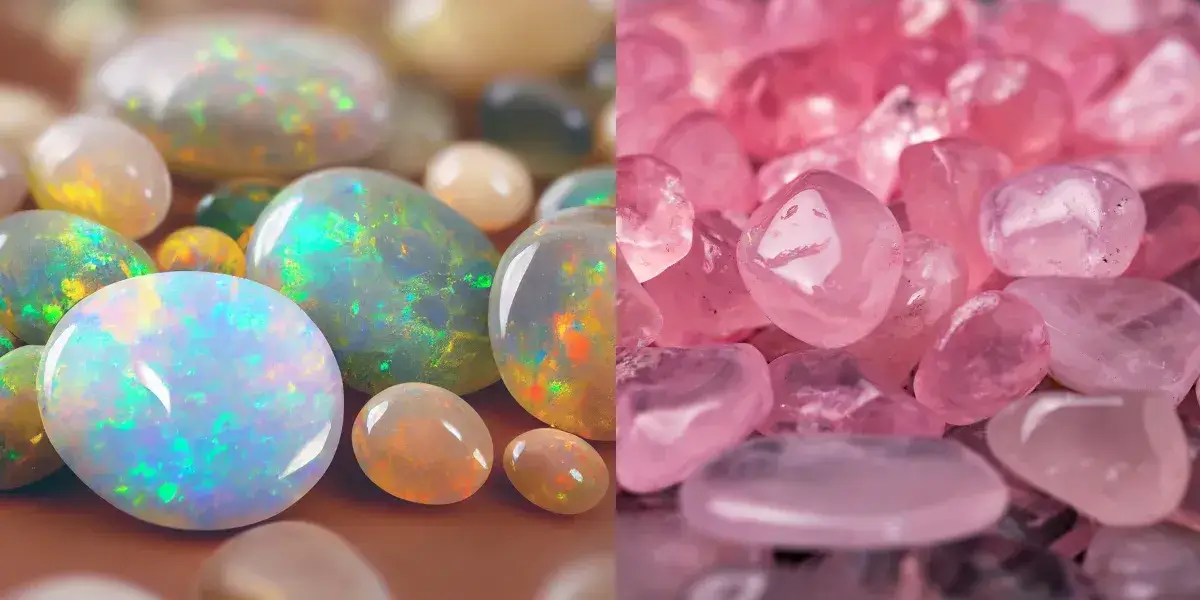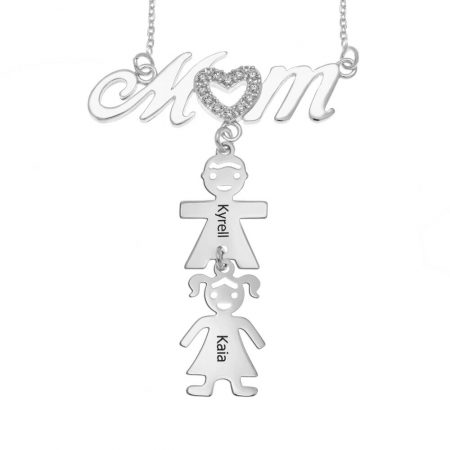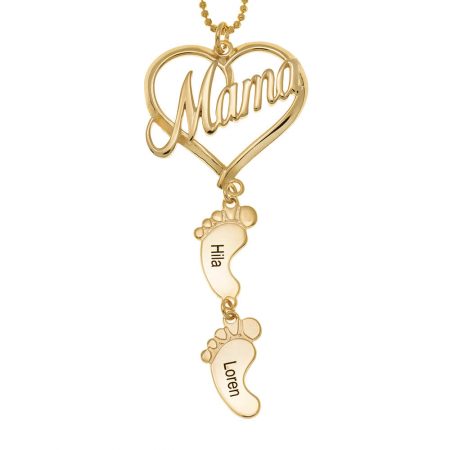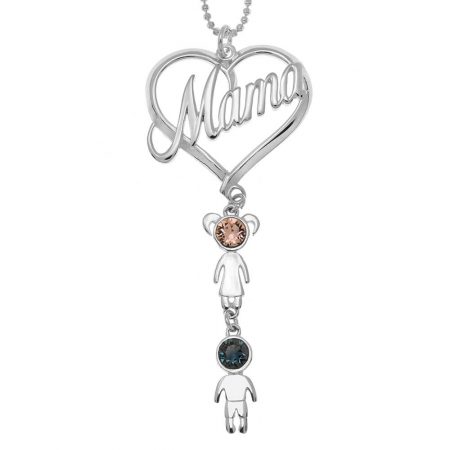October, a month of vibrant colors and shifting seasons, is adorned with two exquisite birthstones: Opal and Pink Tourmaline. Each gem possesses a unique symbolism and meaning, captivating the hearts of those born in this enchanting month.
In this comprehensive exploration, we dive into the rich history, mystical properties, and cultural significance of October’s birthstones, shedding light on the profound connections they hold with those who wear them.
Join us on a journey of discovery as we uncover the fascinating tales behind these radiant gems and celebrate the beauty they bring to personalized jewelry.
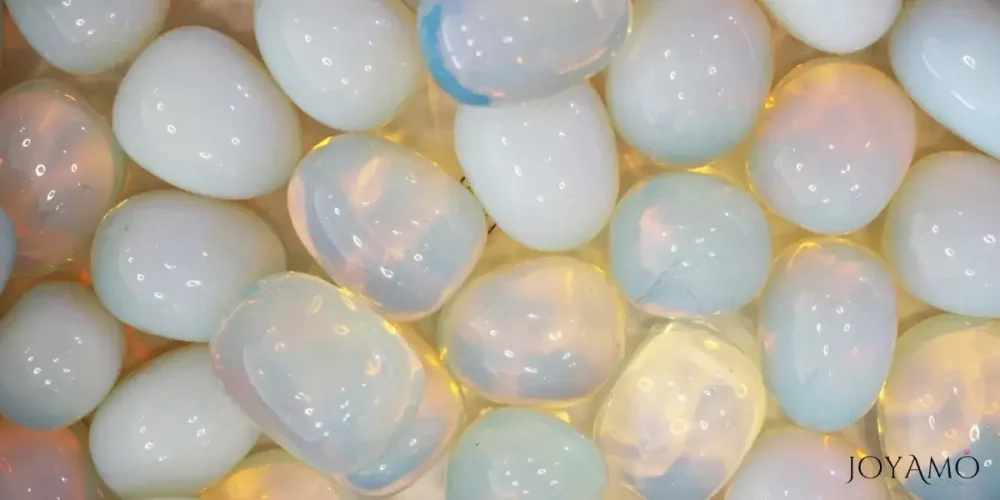

OCTOBER BIRTHSTONE
What is October’s birthstone?
October, known for its autumn colors, has two captivating birthstones: Opal and Pink Tourmaline. People born in October get to enjoy two stunning birthstones that, at the same time, make stunning jewelry pieces.
What are the Two October Birthstones?
The two birthstones of October are:
Opal and Pink Tourmaline
👉🏻 Opal, with its play of colors, holds a sense of mystery and enchantment.
The shifting hues, called opalescence, are thought to embody the essence of all gemstones, representing hope, purity, and creativity. Opal has been treasured throughout history by different cultures.
The ancient Greeks linked it to foresight and prophecy, while the Romans saw it as a symbol of hope and purity.
👉🏻 Pink Tourmaline emits a pink glow that conveys feelings of love, compassion, and emotional healing. This gem is valued for its ability to encourage self-love, attract energy, and promote harmony.
Pink Tourmaline is often associated with matters of the heart; fostering empathy, forgiveness, and harmony in relationships.
Whether you are drawn to the charm of Opal or the soothing warmth of Pink Tourmaline, October’s birthstones hold symbolism and significance for your personalized jewelry collection.
Discover with us the history and tradition as we uncover the captivating world of October’s birthstones and their deep connections with those born under their influence.
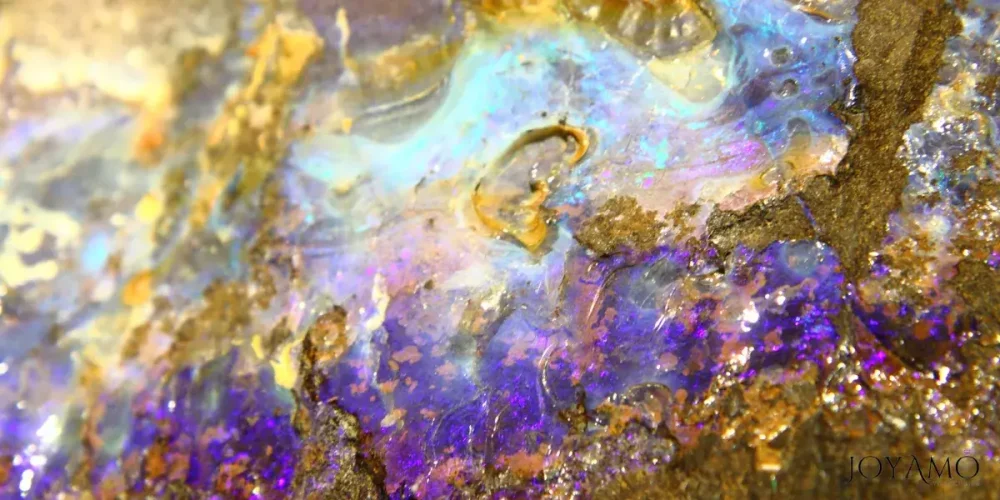
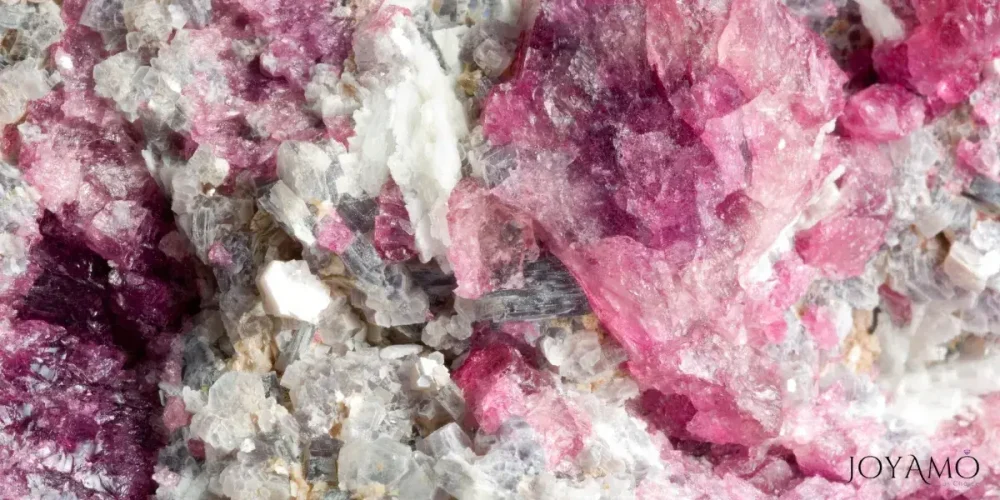
Why does October have 2 birthstones?
October’s dual birthstones, Opal and Pink Tourmaline, offer individuals born in this month a unique spectrum of colors and meanings to choose from.
The practice of assigning multiple birthstones to a single month is relatively modern and stems from a desire to provide variety and flexibility.
Opal, with its captivating play-of-color, represents creativity, hope, and purity, while Pink Tourmaline embodies love, compassion, and emotional healing with its delicate rosy hue.
By offering two birthstones, October celebrates the diverse preferences and personalities of its individuals, allowing them to connect with a gemstone that resonates most deeply with their spirit and desires.
Additionally, having two birthstones fosters a sense of inclusivity and allows for a broader exploration of gemstone lore, symbolism, and cultural significance, enriching the experience of those born in October as they embrace their unique birthstone journey.
OPAL
a) History of Opal
The opal, known for its captivating display of colors, has fascinated people for centuries, creating a tapestry of stories and legends that have been passed down through time.
Though thought to have originated 100 million years ago, ancient civilizations valued opals for their mystical qualities and stunning appearance.
In Rome, opals were highly regarded as symbols of hope and purity. Pliny the Elder, a naturalist, described opals as possessing the tones of both rubies and emeralds, capturing the essence of all gemstones within their shimmering surfaces.
The Romans believed that opals brought love and good fortune to those who wore them, warding off negativity and attracting energy.
During the Middle Ages, opals were linked to concepts of loyalty and faithfulness.
They were often worn as charms to protect against illnesses and safeguard the eyesight of individuals. However, there were periods in history when superstitions surrounding opals led to fears of luck and disease.
The discovery of deposits in Australia in the 20th century reignited interest in these alluring gemstones. Australian opals became renowned for their displays of color, quickly becoming associated with luxury and extravagance.
Opals remain captivating and inspiring today, treasured for their mesmerizing beauty and distinctiveness.
Whether it’s the Mexican fire opals or the ethereal Australian opals, these gemstones retain an enduring charm that beckons us to explore their enchanting past and embrace the enchantment they represent.
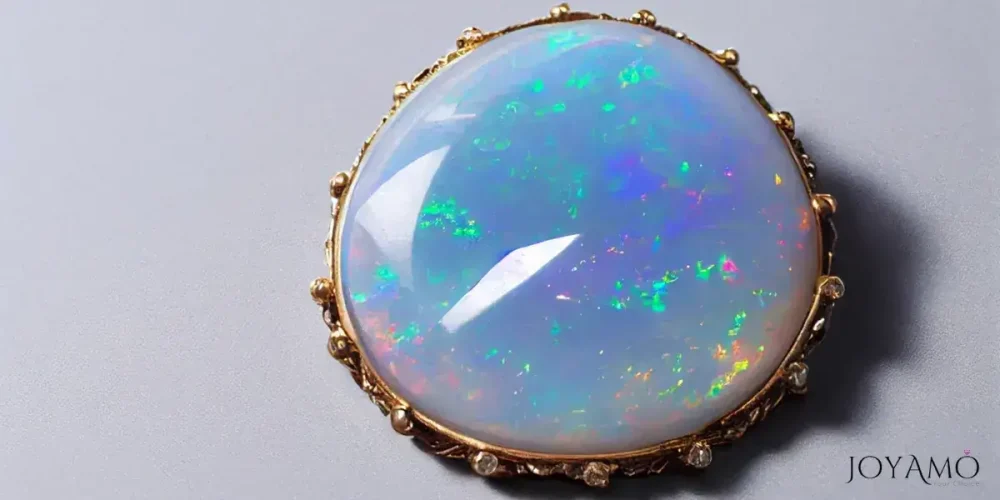
b) Properties of Opal
Opals are widely known for their enchanting display of colors that make them stand out among gemstones.
This dazzling effect is created by diffraction through tiny silica spheres in the opal’s structure, resulting in a range of hues, like red, orange, yellow, green, blue, and violet, shimmering across the gemstone’s surface.
Apart from their allure, opals have characteristics worth noting. They are relatively soft compared to gems, typically scoring between 5.5 and 6.5 on the hardness scale, making them vulnerable to scratches and wear that require delicate handling to maintain their beauty.
Opals contain an amount of water ranging from 3% to 21% by weight. This high water content makes them prone to dehydration over time, impacting their stability and appearance.
To prevent dehydration, opals may be stored in moist conditions. Treated with oils or other substances to preserve their moisture levels.
Opals are classified into types such as opals, which have striking color effects, and common opals lacking this distinctive optical display.
Opals come in categories based on the colors they display, like pinfire, harlequin, and ribbon patterns. These patterns enhance their beauty and value.
Besides their appeal, opals are also linked to metaphysical and healing properties. They are believed to boost creativity, ignite inspiration, and support well-being.
Opals are often seen as symbols of hope, love, and purity, making them popular choices for engagement rings and sentimental jewelry pieces.
In essence, opals stand out as unique gemstones appreciated for their captivating play of color, intriguing qualities, and deep symbolism throughout time.
Admired for their beauty or valued for their attributes, opals continue to fascinate and inspire gem lovers worldwide.
❗ Types of Opals and their characteristics
| Opal Type | Characteristics |
|---|---|
| White Opal | Milky white or light-colored base with flashes of various colors, including red, green, and blue. |
| Black Opal | Dark body tone with vibrant play-of-color, often against a black or dark gray background. |
| Fire Opal | Transparent to translucent opal with warm hues of orange, red, and yellow. |
| Boulder Opal | Opal embedded within ironstone or sandstone matrix, displaying vibrant play-of-color patterns. |
| Crystal Opal | Transparent to semi-transparent opal with vivid play-of-color, often with a clear or translucent base. |
| Matrix Opal | Opal from Ethiopia, is known for its bright play-of-color against a dark base. |
| Ethiopian Opal | Opal from Lightning Ridge, Australia, is prized for its high-quality play-of-color and rarity. |
| Lightning Ridge Opal | Opal from Lightning Ridge, Australia, prized for its high-quality play-of-color and rarity. |
| Coober Pedy Opal | Opal from Mexico, is characterized by warm hues of orange, red, and yellow, resembling flames. |
| Mexican Fire Opal | Opal from Ethiopia, is known for its bright play of color against a dark base. |
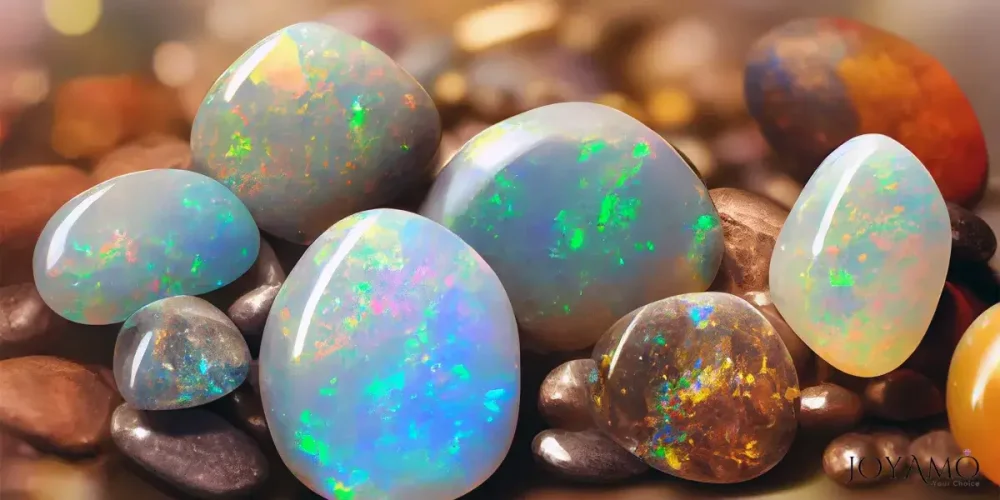
c) Opal Discoveries and Mining
The history of discoveries and mining has played a role in human civilization, spanning across different parts of the world and cultures in search of this captivating gemstone.
Throughout history, opals have been extracted from locations globally, including Australia, Ethiopia, Mexico, Brazil, and the United States.
Australia has always been a player in mining, especially in regions like Lightning Ridge, Coober Pedy, and Andamooka. Indigenous Australians were the first to stumble upon opals in these areas, followed by settlers who established mining operations during the 19th century.
Lightning Ridge stands out for its opals, renowned for their play of color set against a dark base.
On the other hand, Coober Pedy is famous for its underground mining techniques, where miners delve into subterranean tunnels to seek out opals while escaping the intense desert heat.
In Ethiopia, opal mining gained significance in the 1990s with opal discoveries, in the Wollo Province.
These Ethiopian Welo opals are highly prized for their play of color and transparency, which rival the finest Australian varieties.
Mexico’s Querétaro and Jalisco regions have also made their mark as sources of fire opals known for their orange and red tones.
Brazilian opal reserves, mainly located in Minas Gerais, have significantly impacted the market by offering a variety of opals ranging from milky white to vibrant red hues.
The methods employed for mining vary based on the characteristics of each deposit. Traditional techniques encompass open pit mining, underground tunneling, and hydraulic mining.
Recent technological advancements, like drilling methods and aerial surveys, have transformed exploration and extraction processes, resulting in more effective and sustainable mining approaches.
Despite the obstacles and dangers associated with mining, the fascination with uncovering these gemstones continues to motivate miners and prospectors to venture into new territories in pursuit of opal treasures.

d) Opal in Jewelry
Opals have always been highly regarded in the world of jewelry, captivating both designers and jewelry lovers with their enchanting beauty and colorful display.
Known for their mesmerizing iridescence, opals have symbolized hope, purity, and creativity throughout history.
In the realm of jewelry, opals are valued for their versatility, as they can be crafted into a variety of designs ranging from timeless solitaire rings, to statement necklaces.
Opals play a role in jewelry, particularly as the birthstone for October. As the birthstone for October, opals carry meaning for individuals born in this month, representing love, passion, and emotional healing.
In jewelry pieces, opals provide a way to commemorate birthdays, anniversaries, or other important milestones.
Showcased in a dainty pendant, a pair of earrings, or an eye-catching cocktail ring; opals bring an element of charm and uniqueness to any jewelry item.
Their captivating play of color makes them an exceptional choice for those looking for a significant gemstone to enhance their jewelry collection.
Jewelry enthusiasts also appreciate opals for their qualities and natural allure.
Each opal is unique, showcasing its blend of colors and designs, which adds to its charm as a precious gemstone.
Whether it’s the Mexican fire opals or the radiant Australian ones, these gems never fail to enchant and excite jewelry enthusiasts globally, solidifying their timeless appeal, in the jewelry industry.
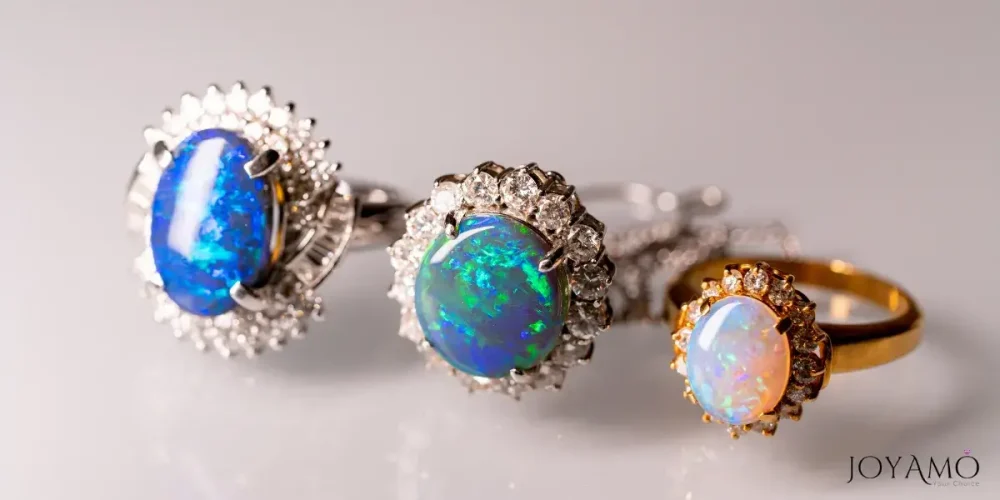
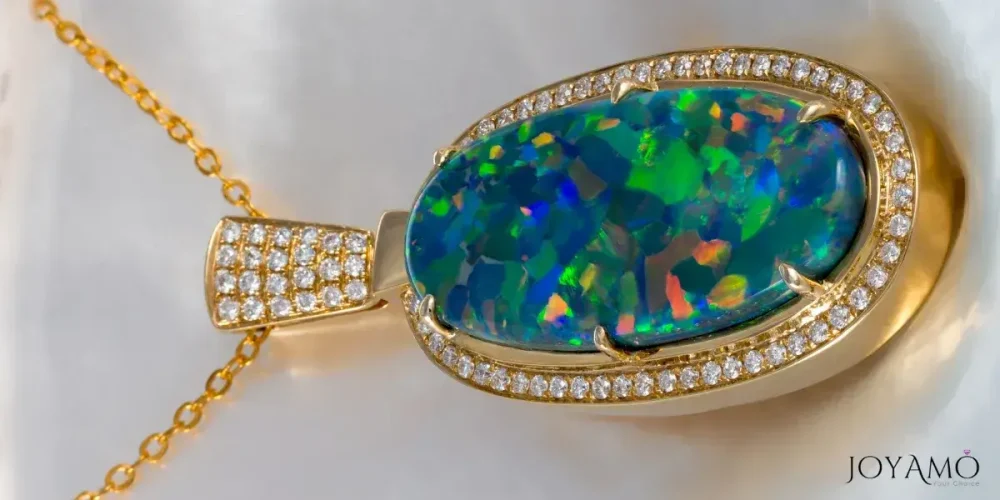
e) How to take care of Opal Jewelry
Opal jewelry is both fragile and mesmerizing, needing attention to preserve its timeless charm.
To keep your pieces shining bright, here are some suggestions:
- Gentle Cleaning: Use a cloth to delicately wipe off any dirt or debris from your opal jewelry. Steer clear of chemicals or cleaners that could harm the opal’s surface.
- Storage: Keep your jewelry separate, from pieces to prevent scratches. You can consider wrapping each item in a cloth or storing them in pouches to reduce friction.
- Avoid Exposure: Opals are sensitive, to temperature changes and excessive sunlight, which may lead to fading or cracking. Remember to take off your jewelry before swimming showering or working out to shield them from harm.
- Periodic Moisture: Opals contain a bit of water so it’s crucial to prevent them from drying out. Occasionally moisturize your jewelry by placing it on a cloth briefly but avoid prolonged exposure to moisture.
- Professional Attention: Think about getting your jewelry professionally cleaned and checked now and then to ensure it stays in top-notch condition.
By sticking to these maintenance suggestions you can ensure that the classic charm of your accessories lasts for decades to come.
Follow these tips to enjoy stunning pieces of jewelry embellished with opals that will have a special place in your jewelry box.
PINK TOURMALINE
a) History of Tourmaline
Tourmaline, renowned for its range of colors and unique crystal formations, has a diverse history that mirrors the beauty of the gemstone itself.
The term “tourmaline” originates, from the phrase “tura mali,” which translates to “stone of colors,” perfectly capturing the essence of this gem known for its vibrant hues.
Throughout history, various cultures have valued tourmaline. Ancient societies like the Egyptians and Romans esteemed tourmaline for its believed ability to boost energy and stimulate creativity.
In culture, tourmaline served as a charm against negative forces while fostering harmony and equilibrium.
In the century, European adventurers introduced tourmaline to regions, igniting a newfound interest in this colorful stone.
It quickly gained popularity among royalty, who flaunted tourmaline jewelry as symbols of affluence and prestige.
The 19th century witnessed the discovery of tourmaline deposits in Brazil, leading to a surge in demand for this precious stone.
Brazilian tourmalines, prized for their colors and clarity, have become highly coveted by gem aficionados and jewelry connoisseurs worldwide.
Today, tourmaline continues to be revered for its beauty and versatility.
Tourmaline comes in a variety of colors, like pink, green, blue, yellow, and even bicolored or multicolored types known as watermelon tourmaline. Each color is associated with its metaphysical meanings.
Pink symbolizes love and compassion, green signifies abundance and prosperity, while blue encourages clear communication and self-expression.
Aside from its appeal, tourmaline is believed to have healing properties and metaphysical energies. It is thought to purify the body, mind, and spirit, promoting peace, emotional harmony, and spiritual growth.
From time to time, jewelry makers’ tourmaline continues to enchant and inspire with its exquisite beauty and fascinating history. This ensures its enduring popularity as one of the best gemstones in the world.
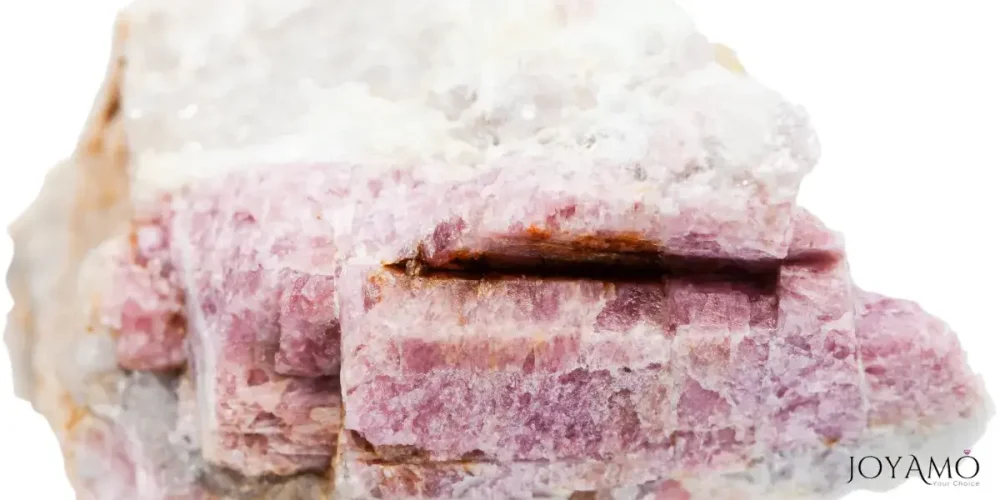
b) Properties of Tourmaline
Tourmaline, a gem highly valued for its range of colors and unique crystal structures, boasts a set of characteristics that make it both visually stunning and versatile.
One of the qualities of tourmaline is its ability to exhibit pleochroism, where it can showcase varying hues depending on the viewing angle.
This captivating optical effect enhances the gem’s charm, creating a captivating interplay of colors that span from pinks and greens to blues and purples.
Apart from its features, tourmaline is also celebrated for its durability. With a hardness rating between 7 and 7.5 on the scale, tourmaline is relatively resistant to scratches and abrasions, making it suitable for jewelry applications.
Pink tourmaline holds significance among gem lovers due to its attributes and symbolism. It is linked to matters of the heart, symbolizing love, empathy, and emotional recovery.
Believed to calm emotions and nurture self-love and acceptance, pink tourmaline is associated with reducing stress and anxiety while promoting balance and harmony in one’s life.
Pink Tourmaline properties
In addition, to its benefit, pink tourmaline is thought to possess healing properties that extend beyond the realm.
Many believe that pink tourmaline can boost the system, improve blood circulation, and contribute to well-being. Moreover, it is thought to stimulate creativity and intuition, making it a favored gem among artists, writers, and those, in search of inspiration and clarity.
Tourmaline, especially the pink variety, continues to enchant and motivate people with its beauty and various metaphysical qualities.
Adorned for its appeal or its perceived healing properties, tourmaline remains a gemstone adored by individuals worldwide.
❗ Types of Tourmalines and their characteristics
| Tourmaline Type | Characteristics |
|---|---|
| Black Tourmaline | Protective, grounding, absorbs negative energies |
| Green Tourmaline | Vitality, abundance, growth |
| Pink Tourmaline | Communication, intuition, andcalmness |
| Blue Tourmaline | Balance harmony and emotional healing |
| Watermelon Tourmaline | Communication, intuition, and calmness |
| Red Tourmaline | Stability, practicality, and grounding |
| Yellow Tourmaline | Creativity, self-confidence, mental clarity |
| Brown Tourmaline | Balance, versatility, spiritual evolution |
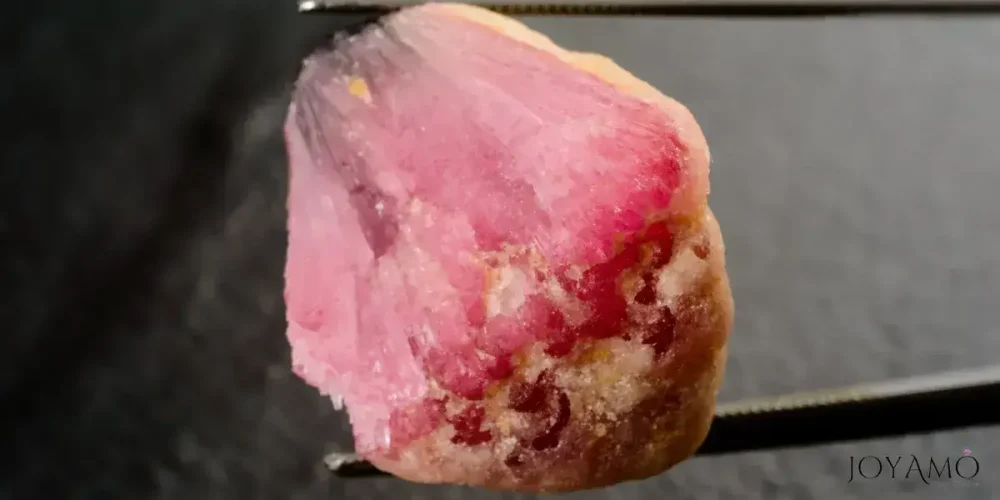
c) Tourmaline Discovery and Mining
Tourmaline, known for its colors and diverse crystal structures, is mined worldwide, with significant deposits discovered in geological settings.
Brazil is a producer of tourmaline, in the state of Minas Gerais, where a variety of colorful specimens like bi-colored and watermelon tourmalines are commonly found.
The United States also stands out as a source, with California, Maine, and the Pala District renowned for their high-quality tourmalines.
Afghanistan, Madagascar, and Nigeria are among the countries with tourmaline deposits that contribute to the gemstone’s popularity.
Pink Tourmaline Mining
Pink tourmaline can be found in mining areas around the world. Minas Gerais in Brazil is one region where pink tourmalines are often mined alongside other types of tourmalines.
Afghanistan’s Nuristan Province is recognized for producing tourmalines known for their soft hues and clarity.
Mozambique has recently become a producer of tourmaline as well, offering gems ranging from light pink to deep magenta.
These mining regions play a role in supplying the market with pink tourmaline valued for its romantic color and believed metaphysical properties related to love and emotional healing.

d) Pink Tourmaline in Jewelry
Tourmaline, known for its colors and fascinating crystal formations, has become a choice in the jewelry world, providing a wide range of hues for both designers and wearers.
Its reputation for being both versatile and durable makes tourmaline highly sought after in creating jewelry pieces, from necklaces to intricate earrings.
In jewelry, tourmaline holds significance, especially as the birthstone for October. Pink tourmaline is particularly revered as October’s birthstone, representing love, compassion, and emotional healing.
This makes pink tourmaline a good choice for jewelry pieces commemorating birthdays, anniversaries, graduations, and other important occasions.
Whether showcased in a pendant, a pair of earrings, or a classic bracelet, pink tourmaline brings a touch of romance and sentimental value to personalized jewelry designs.
Its gentle pink color serves as a symbol of the wearer’s strength, resilience, and capacity for love, making it a cherished gemstone for individuals born in October.
Apart from its association with birthstones, tourmaline is highly favored by jewelry enthusiasts due, to its mesmerizing beauty and adaptability.
The tourmaline’s lush green hues and the tourmaline’s vibrant red tones showcase distinct charms, making each gemstone a favorite, in personalized jewelry.
Whether for its beauty or its symbolic, meaning, tourmaline remains a source of inspiration, for creating expressive jewelry pieces.
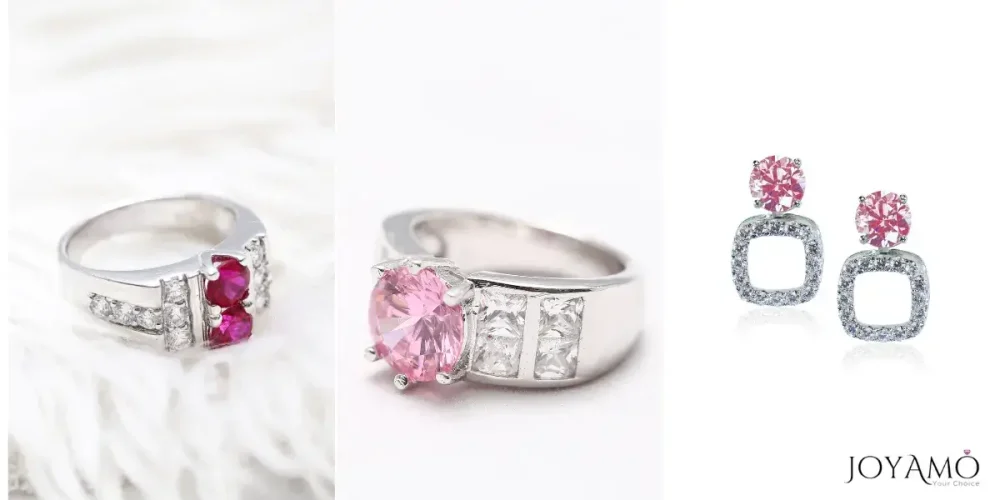
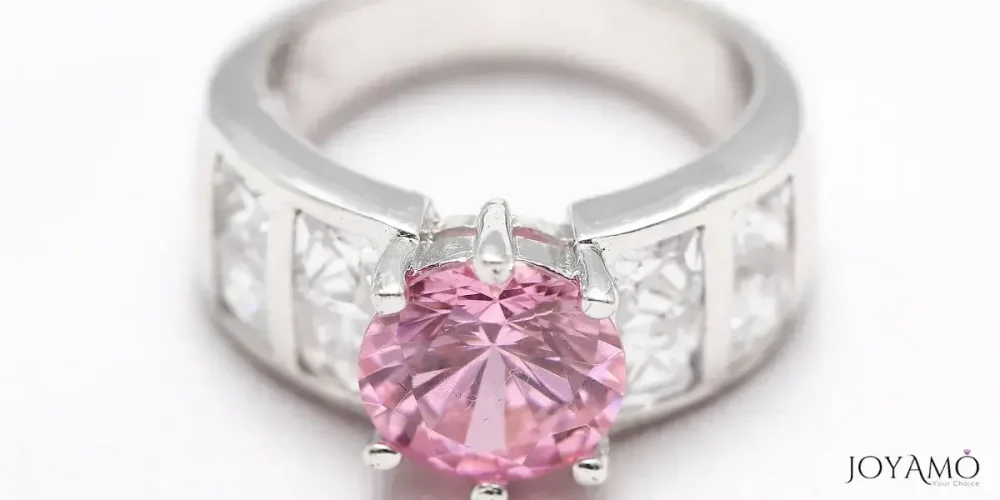
e) How to take care of Pink Tourmaline Jewelry
Taking care of your pink tourmaline jewelry is crucial, to maintaining its blush tones for years.
Here are some important suggestions to preserve the allure of your pieces:
- Gentle Cleaning: Regularly clean your pink tourmaline jewelry using a lint cloth to eliminate dirt and oils. For a cleanse use soap mixed with warm water and softly brush with a gentle brush. Avoid chemicals or abrasive cleaners that could harm the gemstone surface.
- Storage: Keep your pink tourmaline jewelry in a compartment or pouch to prevent scratching or tangling with items. Consider wrapping them in fabric or tissue paper for added protection.
- Steer Clear of Extreme Conditions: Pink tourmaline is sensitive to temperature fluctuations and sunlight exposure. Refrain from subjecting your jewelry to heat or cold as well as prolonged sunlight exposure, which may lead to fading or discoloration.
- Minimize Contact: Reduce the contact of your pink tourmaline jewelry with chemicals, perfumes, and cosmetics as these substances can diminish or harm the gemstone’s quality over time.
- Professional Evaluation: Periodically have your pink tourmaline jewelry assessed by a jeweler, for settings or signs of wear and tear. Professional cleaning can also help revive its sparkle and luster.
Follow these tips and suggestions so that your pink tourmaline pieces of jewelry will maintain their allure and hold a special place in your jewelry collection for years to come shimmering beautifully each time you wear them.
DIFFERENCES BETWEEN OPAL AND TOURMALINE
The table below highlights the most important key differences between opal and tourmaline, including their composition, color range, optical phenomena, hardness, birthstone status, and cultural significance.
| Characteristic | Opal | Tourmaline |
|---|---|---|
| Composition | Hydrated silica | Complex borosilicate mineral |
| Color Range | Various, including white, black, and iridescent play-of-color | Wide range, including pink, green, blue, black, and multicolored |
| Optical Phenomenon | Iridescence caused by light diffraction | Colors caused by trace elements in crystal structure |
| Hardness | 5.5–6.5 on the Mohs scale | 7-7.5 on the Mohs scale |
| Birthstone | One of October’s birthstones, symbolizing hope and purity | One of October’s birthstones, often associated with Libra, symbolizes love and compassion |
| Cultural Significance | Revered by various cultures for its mystical properties and beauty | Prized by ancient civilizations for its supposed healing properties and vibrant colors |
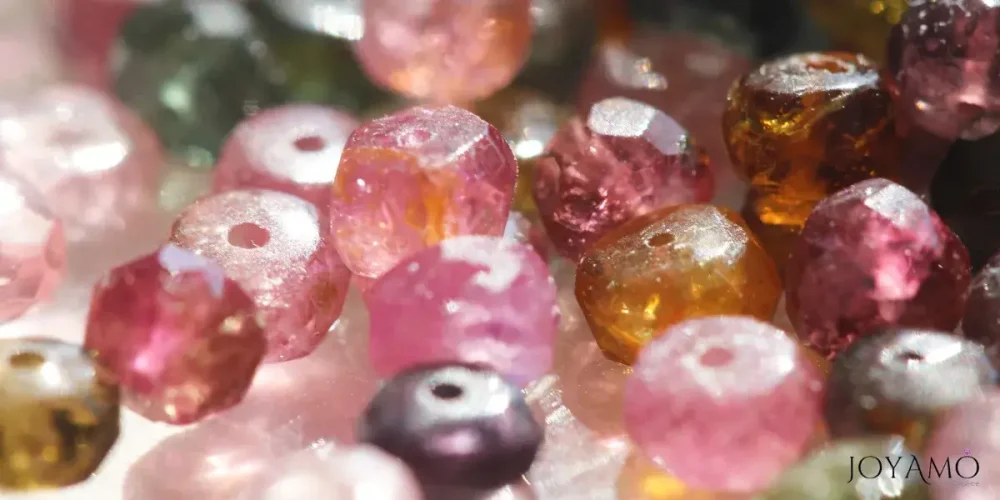

OCTOBER BIRTHSTONE AND THE ZODIAC ♎
Zodiac followers will love to know the secrets of the October birthstones and their relationship with Libra!
October, a month rich in symbolism and beauty, welcomes two captivating birthstones: opal and pink tourmaline.
These gems, each unique in their appearance and significance, share a profound connection with the zodiac sign associated with October, Libra ♎
Libra, the seventh sign of the zodiac, is represented by the scales, symbolizing balance, harmony, and justice.
Those born under this air sign are often characterized by their diplomatic nature, charm, and desire for fairness in all aspects of life.
Opal, with its enchanting play-of-color and ethereal beauty, resonates deeply with Libra’s quest for balance and harmony.
Just as the scales seek equilibrium, opal embodies the harmony of light and color, reflecting a spectrum of hues that dance within its depths.
This gemstone encourages Librans to embrace their creativity, intuition, and adaptability, fostering a sense of equilibrium in their lives.
Pink tourmaline, as one of October’s birthstones and often associated with Libra, further enhances the sign’s qualities of love, compassion, and emotional balance.
The soft pink hue of tourmaline embodies the gentle, nurturing energy of Libra, promoting harmony in relationships and encouraging empathy and understanding.
Pink tourmaline serves as a reminder for Librans to cultivate self-love and compassion, fostering deeper connections with others and fostering a sense of unity and peace.
Together, opal and pink tourmaline offer Librans a harmonious blend of energies, supporting their journey toward balance, harmony, and emotional well-being.
Included in a jewelry set or kept close as talismans, these birthstones serve as gentle reminders of the inherent beauty and balance found within the Libra spirit, guiding them toward a life filled with love, peace, and harmony.
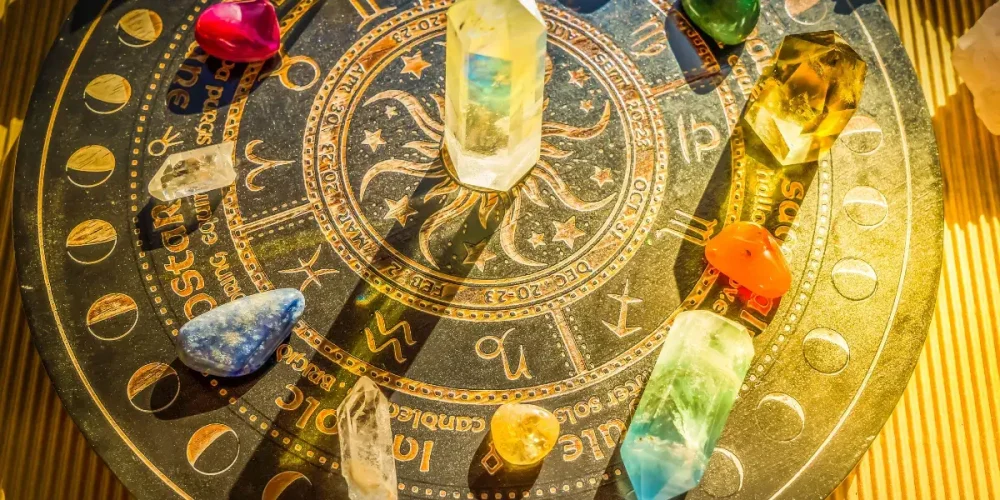
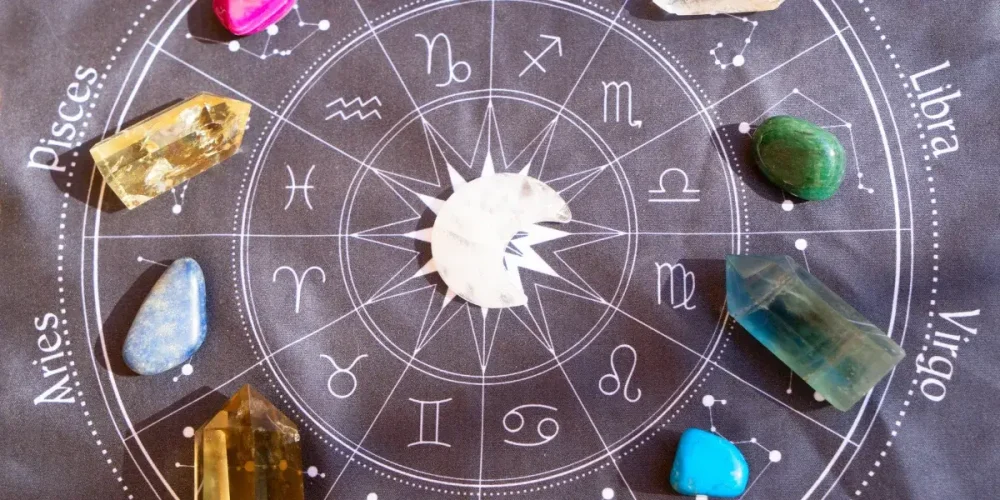
| Month | Zodiac Sign | Birthstones |
|---|---|---|
| January | ♑ Capricorn | Garnet |
| February | ♒ Aquarius | Amethyst |
| March | ♓ Pisces | Aquamarine, Bloodstone |
| April | ♈ Aries | Diamond |
| May | ♉ Taurus | Emerald |
| June | ♊ Gemini | Pearl, Moonstone, and Alexandrite |
| July | ♋ Cancer | Ruby |
| August | ♌ Leo | Peridot |
| September | ♍ Virgo | Sapphire |
| October | ♎ Libra | Opal, Tourmaline |
| November | ♏ Scorpio | Topaz, Citrine |
| December | ♐ Sagittarius | Turquoise, Zircon, and Tanzanite |
Birthstones and Astrological Signs
In the realm of jewelry, few things carry as much meaning and elegance, as birthstones and astrological signs.
These enduring symbols have been intertwined throughout history, symbolizing identity, safeguarding, and individual expression.
Studying the connection between birthstones and astrological signs reveals a journey of alignment and uniqueness.
Tracing back in time, both birthstones and astrological signs have played roles in human customs and spirituality.
Birthstones, believed to have originated from the breastplate of Aaron in the Hebrew Bible were linked to months with properties and meanings.
Similarly, astrological signs, encompassing twelve symbols have steered individuals through the forces thought to influence personalities and fates.
The bond between birthstones and astrological signs lies in their shared symbolism and harmony with the bodies.
Each zodiac sign corresponds to months of the year each associated with birthstones.
For instance, garnet is tied to January symbolizing love, companionship, and protection—attributes that align well with Capricorn’s ambitious nature as the ruling zodiac sign, for January.
This intricate connection allows for jewelry pieces that deeply resonate with individuals.
Whether it’s a necklace with your birthstone, or a ring featuring your zodiac symbol these jewelry items act as reminders of your individuality and cosmic connection.
Furthermore, the fusion of birthstones and zodiac signs creates a combination of appeal and spiritual significance.
From the energy of rubies for Leos born in July to the tranquil charm of aquamarine for Pisces born in March each gemstone mirrors the essence of its associated zodiac sign.
On the JoyAmo Jewelry online store, we honor this bond by offering a diverse selection of personalized jewelry pieces with birthstones like personalized bracelets crafted with meticulous care.
If you’re looking for a present for someone special or a unique accessory for yourself, our range of birthstone and zodiac-inspired jewelry is designed to enchant your senses and touch your spirit.
Enjoy the enduring charm of birthstones and zodiac symbols, through our exquisite collection of personalized birthstone jewelry, where aesthetics blend seamlessly with symbolism in every carefully designed piece.
| Month | Birthstone | Characteristics |
|---|---|---|
| January | Garnet | The purple hue represents clarity, intuition, and tranquility. |
| February | Amethyst | The deep green color symbolizes rebirth, fertility, and growth. |
| March | Aquamarine | Light blue to green-blue color reminiscent of the ocean associated with courage and clarity. |
| Bloodstone | Dark green with red spots is known for its healing properties and connection to vitality and strength. | |
| April | Diamond | Color-changing gemstones, often shifting from green to red, symbolize good fortune and creativity. |
| May | Emerald | Purple hue represents clarity, intuition, and tranquility. |
| June | Pearl | A play-of-color gemstone symbolizes hope, purity, and creativity. |
| Moonstone | Exhibits adularescence, a milky sheen, symbolizing inner growth, intuition, and emotional healing. | |
| Alexandrite | A rich red gemstone symbolizes passion, love, and prosperity. | |
| July | Ruby | Organic gems formed within mollusks represent purity, innocence, and emotional balance. |
| August | Peridot | The purple hue represents clarity, intuition, and tranquility. |
| September | Sapphire | Olive-green gemstone is associated with strength, healing, and positive energy. |
| October | Opal | Play-of-color gemstone symbolizes hope, purity, and creativity. |
| Tourmaline | Multicolored gemstone, available in various hues, symbolizing love, compassion, and emotional healing. | |
| November | Topaz | Blue gemstone, though comes in various colors, symbolizing wisdom, loyalty, and nobility. |
| Citrine | Yellow to orange gemstone, symbolizes warmth, joy, and abundance. | |
| December | Turquoise | Yellow to orange gemstone, symbolizes warmth, joy, and abundance. |
| Zircon | Colorless to blue gemstone, known for its brilliance and symbolic of wisdom, honor, and wealth. | |
| Tanzanite | Blue to violet gemstone, known for its rarity and connection to spiritual enlightenment and exploration. |
💡 What’s October Birthstone FAQs
✔ What is the real birthstone for October?
October boasts two birthstones: opal and pink tourmaline. Opal, famed for its iridescent play-of-color, symbolizes hope and purity. Pink tourmaline, associated with Libra, represents love and compassion. Both gemstones offer October-born individuals a spectrum of colors and meanings to choose from, making them cherished choices for personalized jewelry.
✔ What is the birthstone for October Libra?
While both opal and tourmaline are recognized as birthstones for October, tourmaline is often associated with the zodiac sign Libra, which falls within October. Pink tourmaline, specifically, is revered for its symbolism of love, compassion, and emotional healing, aligning with Libra’s traits of harmony and balance.
✔ What is the difference between opal and tourmaline?
Opal and tourmaline have characteristics that set them apart, such as their makeup, appearance, and traits. Opal is made up of hydrated silica. Displays a captivating play of colors, due to diffraction. In contrast, tourmaline is a borosilicate mineral with a color palette ranging from pink and green to blue and black. While opal shines with its iridescence the vibrant hues of tourmaline stem, from trace elements nestled within its crystal lattice.
 SHIPPING
SHIPPING
